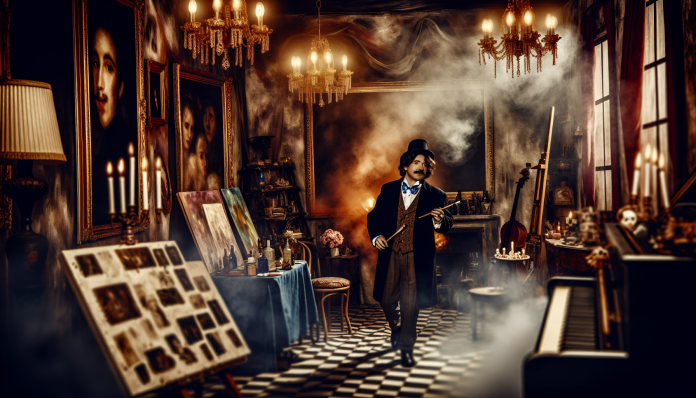Introduction
Lord George Gordon Byron, a titan of English literature and an iconic figure of the Romantic era, was as notorious for his scandalous lifestyle as he was celebrated for his poetry. Born in 1788, Byron exemplified the complexities of early 19th-century societal norms, mixing romantic idealism with a hedonistic approach to life that often landed him in hot water. Among the most sensational aspects of Byron’s life were the wild orgies and libertine episodes that became closely associated with his name, capturing the fascination—and disapproval—of his contemporaries.
This era, characterized by strict moral standards and a rigid class system, stood in stark contrast to the passions that Byron openly pursued. His peerage offered him a degree of freedom, yet it simultaneously subjected him to intense scrutiny. This article delves into Byron’s life to examine not only the scandalous nature of his escapades but also how societal reactions shaped the narrative surrounding him, juxtaposed with contemporary attitudes toward sexuality and personal liberty.
The Scandal
A Reckless Romantic
Byron’s literary career truly blossomed in the early 19th century, with works like Childe Harold’s Pilgrimage and Don Juan gaining him a significant following. However, it was his personal life that often eclipsed his literary accomplishments. Byron’s exploits included a series of passionate affairs, rumored love affairs, and outright debauchery that scandalized London society.
One notable scandal involved his relationship with the infamous Lady Caroline Lamb, who famously described Byron as “mad, bad, and dangerous to know.” Their tumultuous affair revealed Byron’s penchant for seduction and drama but also invited both admiration and condemnation. The couple was embroiled in a media frenzy, with newspapers widely reporting on their passionate yet destructive romance.
The cherry on top of Byron’s scandalous lifestyle was his well-documented participation in lavish, excessive parties, often characterized as orgies. Byron’s gatherings at the Villa Diodati in Switzerland, where he spent time with fellow poets like Percy Bysshe Shelley, were infamous for their uninhibited excesses involving wine, poetry recitals, and illicit relationships, creating an atmosphere of uninhibited revelry.
Public Reaction and Cultural Impact
In the conservative atmosphere of Regency England, Byron’s lifestyle was a potent mix of admiration and outrage. Many members of the upper class rejected Byron’s blatant disregard for social convention, viewing him as a disruptive force. The pamphlets and periodicals of the day frequently criticized his romantic escapades, referring to him as a “libertine” and a “seducer,” while also glamorizing his talent and charisma. Social clubs that catered to the elite often served as gossip mills, with tales of Byron’s sexual escapades weaving their way into public consciousness.
At the peak of his scandalous reputation, Byron fled England to escape the mounting pressures of public scrutiny and personal betrayal. His departure signaled a partial victory for the conservative elements of society, who viewed his behavior as a threat to their moral order. Yet Byron remained a beloved figure among some for whom his libertine antics suggested a life lived authentically, reveling in the contrast between high art and low morals.
Moral and Cultural Analysis
Historical Perspective
The Regency period was marked by stringent moral values, particularly regarding sexuality. The idea of propriety dictated the behaviors of the upper class, particularly in matters of love and relationships. Adultery, premarital relationships, and open discussions about sex could bring about societal ruin, which made Byron’s lifestyle all the more sensational. However, beneath this veneer of decorum, societal complexities often included hidden affairs, clandestine liaisons, and stark contradictions that Byron embodied.
Public reception of Byron represents a fascinating paradox: he was simultaneously decried as a scandalous figure and embraced as an artistic genius. Sociologists and historians analyzing Byron’s tumultuous life often point to the clash between Enlightenment ideals—advocating for personal freedom and self-exploration—and the moral rigidity of the time.
Modern Comparisons
Fast forward to today’s society, where discussions about sexual freedom and individual expression have become progressively more open, the reaction to Byron’s lifestyle would likely be vastly different. Contemporary audiences might regard Byron as a symbol of sexual liberation rather than a source of scandal. His explorative relationships and free spirit align more closely with modern ideals of sexual empowerment and acceptance of diverse sexual orientations and lifestyles.
The shifting perceptions run deep: while critics in, say, the 1820s would have condemned Byron as a cultural menace, a modern liberal audience might champion him as a figure challenging restrictive societal norms. His life becomes a testament to embracing one’s identity and desires standing at odds with societal expectations—values many actively promote today.
Conclusion
The wild orgies of Lord Byron reveal more than just the eccentricities of a literary figure; they uncover the shifting sands of societal attitudes towards sex, power, and personal freedom. Byron was a product of his time, yet his life also transcended it, hinting at the beginnings of modern liberated thinking. His narrative opens a dialogue about how history influences contemporary values, particularly in the context of sexuality and personal autonomy.
As we reflect on Byron’s legacy, we are encouraged to think critically about how far we have come—and how far we have yet to go—in reconciling individual desires with societal expectations. In an age where personal freedom often clashes with cultural mores, it’s a conversation that remains as relevant now as it was in Byron’s tumultuous era. Whether we view Byron as a cautionary tale or a beacon of freedom, his story serves as a reminder of the complexities of human desires and the shifting landscape of morality through the ages.

